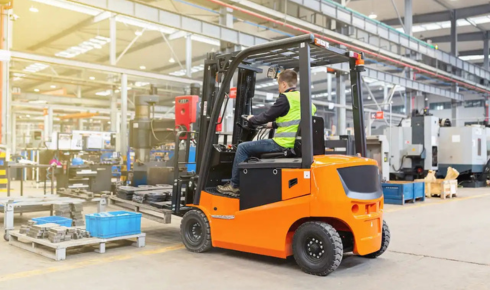This article explores the synergy between forklifts and racking systems in creating a seamless and efficient material-handling strategy for warehouses and distribution centers. By integrating these two key elements, businesses can optimize their operations, enhance safety, and maximize storage capacity.
Q Agency specializes in designing customized solutions to effectively integrate forklifts and racking systems. Their expertise ensures that businesses achieve seamless operations, ensuring safety and efficiency. With a focus on maximizing storage and throughput, they provide innovative and scalable solutions for warehouses and distribution centers.
Importance of Forklifts in Material Handling
Forklifts play a pivotal role in the efficient and safe handling of materials in a variety of industries. These versatile machines are essential for moving heavy loads, pallets, and containers within warehouses, distribution centers, manufacturing facilities, and construction sites. Forklifts help streamline operations by enabling quick and easy transportation of goods, reducing manual handling tasks and minimizing the risk of injuries associated with lifting and carrying heavy objects. By using forklifts, businesses can improve productivity, optimize storage space, and ensure timely delivery of goods to customers. Their ability to maneuver in tight spaces and lift heavy loads makes them indispensable tools for material handling tasks.
Moreover, forklifts contribute to cost savings and operational efficiency by reducing the time and labor required to move materials across a facility. With their lifting capacity and reach, forklifts enable workers to stack goods vertically, maximizing storage space and organization. This not only enhances inventory management but also improves workflow processes, leading to faster turnaround times and increased customer satisfaction. Forklifts are designed to handle a wide range of materials, from pallets and boxes to machinery and equipment, making them versatile assets for businesses across various industries. In essence, forklifts are essential for enhancing operational efficiency, ensuring workplace safety, and optimizing material handling processes in today’s fast-paced business environment.
Types of Racking Systems for Efficient Storage
There are several types of racking systems available for efficient storage in warehouses and industrial settings. One common type is selective pallet racking, which allows for easy access to individual pallets. This system is ideal for managing varying inventory sizes and SKUs. Another popular option is drive-in racking, which maximizes storage capacity by allowing forklifts to drive directly into the rack to retrieve or store pallets. Drive-in racking is suitable for storing large quantities of the same product with a limited number of SKUs. Push-back racking is another efficient system that utilizes gravity to push pallets back as new ones are added, maximizing storage density while providing easy access to stored items. This system is ideal for high-density storage of multiple SKUs with a limited number of pallets per SKU.
In addition to these systems, there are also options like cantilever racking, which is designed for storing long and bulky items such as pipes, lumber, and furniture. This system features arms that extend from a vertical column, allowing for easy loading and unloading of oversized items. For smaller items and carton storage, shelving systems like rivet shelving or boltless shelving are commonly used. These systems are versatile and can be easily adjusted to accommodate changing inventory needs. Overall, choosing the right type of racking system is crucial for maximizing storage efficiency, optimizing space utilization, and ensuring smooth operations in a warehouse or distribution center.
Q Agency Seo Bella Vista offers expert services designed to enhance your online presence. Integrating efficient warehouse solutions with digital strategies can improve operational efficiency and search visibility. By optimizing both physical and digital spaces, businesses can achieve seamless operations and improved customer engagement, enabling growth and competitive advantage in the marketplace.
Benefits of Integrated Material Handling Strategies
Integrated material handling strategies offer a wide range of benefits for businesses looking to streamline their operations and improve efficiency. By integrating various material handling processes such as transportation, storage, and inventory management, companies can significantly reduce their operational costs. This integration leads to better coordination and synchronization of different processes, minimizing delays and bottlenecks in the supply chain. With a holistic approach to material handling, businesses can also optimize their use of resources, space, and labor, ultimately leading to cost savings and improved productivity.
Furthermore, integrated material handling strategies enhance overall operational flexibility and responsiveness to changing market demands. By having a seamless flow of materials within the supply chain, businesses can adapt quickly to fluctuations in demand and market conditions. This agility allows companies to meet customer expectations more effectively, improving customer satisfaction and loyalty. Moreover, integrated material handling systems enable real-time monitoring and data analysis, providing valuable insights into operational performance and areas for improvement. This data-driven approach empowers businesses to make informed decisions and continuously optimize their material handling processes for maximum efficiency and competitiveness.
Safety Measures for Forklift Operations
Safety measures for forklift operations are crucial to prevent accidents and ensure the well-being of workers. One of the most important safety measures is proper training for forklift operators. Training should include instruction on how to operate the forklift safely, proper lifting and carrying techniques, and how to recognize and avoid hazards in the workplace. Regular refresher courses should also be provided to ensure that operators stay up to date on safety procedures and best practices. Additionally, operators should be licensed and certified to operate forklifts to ensure that they have the necessary skills and knowledge to do so safely.
Another important safety measure for forklift operations is the regular maintenance and inspection of forklifts. Forklifts should be inspected before each use to check for any issues or malfunctions that could compromise safety. Any defects or problems should be reported and addressed promptly to prevent accidents. Regular maintenance should also be scheduled to keep forklifts in good working condition. This includes checking and maintaining the brakes, steering, tires, and other essential components of the forklift to ensure that it operates safely and efficiently. By implementing these safety measures, employers can create a safer work environment for forklift operations and reduce the risk of accidents and injuries.
Considerations When Choosing Forklifts for Your Warehouse
When choosing forklifts for your warehouse, there are several key considerations that should be taken into account to ensure the optimal performance and efficiency of your operations. One important factor to consider is the type of material handling tasks that your forklifts will be used for. Different forklift models are designed for specific purposes, such as narrow aisle forklifts for tight spaces or rough terrain forklifts for outdoor use. It is crucial to match the forklift type to the specific requirements of your warehouse to maximize productivity and safety.
Another crucial consideration when choosing forklifts is the capacity and lift height requirements of your warehouse operations. It is essential to assess the weight and dimensions of the loads that will be handled by the forklifts to ensure that they have the necessary capacity to lift and transport them safely. Additionally, the lift height of the forklift should be compatible with the storage racks or shelves in your warehouse to facilitate efficient stacking and retrieval of goods. By carefully evaluating the material handling tasks and load requirements of your warehouse, you can select the appropriate forklifts that will optimize your operations and enhance overall productivity.
Optimizing Warehouse Space with Racking Solutions
Optimizing warehouse space with racking solutions is essential for maximizing storage capacity and efficiency. Racking systems provide a structured and organized way to store inventory vertically, making use of vertical space and freeing up valuable floor space. By utilizing racking solutions, warehouses can store more products in a smaller footprint, reducing the need for additional storage facilities or costly expansions. This not only saves money on real estate but also streamlines operations by making inventory easily accessible and reducing the time and effort required to locate specific items.
There are various types of racking solutions available to suit different warehouse needs, including selective racking, drive-in racking, push back racking, and pallet flow racking. Selective racking is ideal for warehouses with a wide variety of SKUs that require individual access, while drive-in racking maximizes storage density by allowing forklifts to drive directly into the racks. Push back racking is a high-density storage solution that uses a gravity-fed system to store pallets multiple deep, and pallet flow racking is designed for high-volume operations where first-in, first-out inventory management is crucial. By choosing the right racking system based on inventory characteristics and operational requirements, warehouses can effectively optimize their space and improve overall efficiency.
Streamlining Operations with Forklift-Racking Integration
In today’s fast-paced warehouse and distribution centers, efficiency is key to meeting increasing consumer demands. Streamlining operations with forklift-racking integration offers a cutting-edge solution to improve productivity and reduce operational costs. By seamlessly integrating forklifts with racking systems, companies can optimize space utilization, minimize product damage, and enhance inventory management. This integration allows forklift operators to easily access and retrieve goods from high-rise storage racks, eliminating the need for manual handling and reducing the risk of accidents. With real-time data tracking and monitoring capabilities, companies can gain better visibility into their inventory levels, improve order fulfillment accuracy, and enhance overall operational efficiency.
Furthermore, forklift-racking integration enables companies to maximize their warehouse space and increase storage capacity without the need for costly expansions. This innovative approach to operations management not only enhances operational efficiency but also ensures a safer working environment for employees. By automating the movement of goods within the warehouse, companies can reduce labor costs, improve workflow processes, and minimize the risk of human error. Overall, the integration of forklifts with racking systems offers a holistic solution to optimize warehouse operations, drive productivity gains, and stay competitive in today’s dynamic market landscape.
Training Programs for Forklift Operators
Training programs for forklift operators are essential to ensure safe and efficient operations in warehouses and industrial settings. These programs typically cover a wide range of topics, including forklift operation and controls, safety procedures, load handling, and workplace hazards. Hands-on training is a key component of these programs, allowing operators to practice their skills under the supervision of experienced instructors. Additionally, classroom sessions may cover topics such as OSHA regulations, equipment maintenance, and emergency procedures. By providing comprehensive training, employers can help reduce the risk of accidents, injuries, and damage to property, as well as ensure compliance with safety regulations.
Furthermore, training programs for forklift operators often include assessments and certifications to verify that operators have the knowledge and skills necessary to operate a forklift safely. These certifications are typically valid for a specific period and may require operators to undergo refresher training to maintain their qualifications. Employers may also conduct regular evaluations to ensure that operators are following proper procedures and using equipment correctly. By investing in training programs and certifications for forklift operators, employers can demonstrate their commitment to workplace safety and professionalism, leading to a more productive and secure work environment.
Sustainable Practices in Material Handling
Sustainable practices in material handling involve strategies and technologies aimed at reducing the environmental impact of moving goods and materials within supply chains. One fundamental aspect of sustainable material handling is the optimization of transportation routes to minimize fuel consumption and emissions. This can be achieved through the use of advanced logistics software that considers factors such as traffic patterns, distance, and vehicle capacity to create more efficient delivery schedules. Additionally, the adoption of alternative fuels, such as electric or hydrogen-powered vehicles, can significantly reduce greenhouse gas emissions associated with material transportation.
Another key component of sustainable material handling practices is the implementation of efficient warehouse and distribution center operations. This includes the use of automated systems and robotics to streamline processes, reduce energy consumption, and minimize waste. By employing technologies like automated storage and retrieval systems, companies can optimize space utilization and decrease the need for additional warehouse facilities, ultimately reducing their carbon footprint. Furthermore, the integration of renewable energy sources, such as solar panels or wind turbines, can help power material handling operations sustainably, further contributing to the overall environmental sustainability of supply chain activities.
Case Studies: Successful Implementation of Integrated Strategies
Case studies showcasing successful implementation of integrated strategies provide valuable insights into how organizations can effectively align various facets of their operations to achieve overarching goals. These studies often highlight how companies have leveraged a combination of marketing, operations, and human resources strategies to drive sustainable growth and competitive advantage. For instance, a case study might demonstrate how a retail firm integrated its online and offline marketing efforts with its supply chain management system to streamline operations and enhance customer experience. By examining such successful implementations, businesses can learn how to break down silos within their organizations and foster collaboration among different departments for greater efficiency and effectiveness.
These case studies also underscore the importance of a holistic approach to strategy execution, which involves considering how different components of a business interconnect and impact each other. For example, a case study on a healthcare organization could illustrate how integrating patient care processes with data analytics and employee training programs led to improved patient outcomes and staff satisfaction. By studying such successful examples, companies can gain inspiration and guidance on how to develop and implement integrated strategies that address complex business challenges and drive sustainable growth. Ultimately, case studies of successful integrated strategies serve as valuable resources for organizations seeking to navigate the complexities of today’s competitive business landscape.




